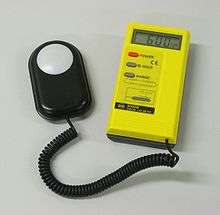Illuminance

In photometry, illuminance is the total luminous flux incident on a surface, per unit area. It is a measure of how much the incident light illuminates the surface, wavelength-weighted by the luminosity function to correlate with human brightness perception. Similarly, luminous emittance is the luminous flux per unit area emitted from a surface. Luminous emittance is also known as luminous exitance.[1]
In SI derived units these are measured in lux (lx) or lumens per square metre (cd·sr·m−2). In the CGS system, the unit of illuminance is the phot, which is equal to 10000 lux. The foot-candle is a non-metric unit of illuminance that is used in photography.[2]
Illuminance was formerly often called brightness, but this leads to confusion with other uses of the word, such as to mean luminance. "Brightness" should never be used for quantitative description, but only for nonquantitative references to physiological sensations and perceptions of light.
The human eye is capable of seeing somewhat more than a 2 trillion-fold range: The presence of white objects is somewhat discernible under starlight, at 5×10−5 lux, while at the bright end, it is possible to read large text at 108 lux, or about 1000 times that of direct sunlight, although this can be very uncomfortable and cause long-lasting afterimages.
Astronomy
In astronomy, the illuminance stars cast on the Earth's atmosphere is used as a measure of their brightness. The usual units are apparent magnitudes in the visible band.[3] V-magnitudes can be converted to lux using the formula[4]
- ,
where Ev is the illuminance in lux, and Mv is the apparent magnitude. The reverse conversion is
- .
See also
References
- ↑ Luminous exitance Drdrbill.com
- ↑ One phot = 929.030400001 foot-candles, according to http://www.unitconversion.org/unit_converter/illumination.html
- ↑ Schlyter, Paul. "Radiometry and photmetry in astronomy FAQ, section 7".
- ↑ "Formulae for converting to and from astronomy-relevant units" (PDF). Retrieved Nov 23, 2013.
- Knowledgedoor, LLC (2005) Library of Units and Constants: Illuminance Quantity
- Illuminance Converter
External links
- A Kodak guide to Estimating Luminance and Illuminance using a camera's exposure meter. Also available in PDF form.
- Autodesk Design Academy - Measuring Light Levels
| Quantity | Unit | Dimension | Notes | |||||
|---|---|---|---|---|---|---|---|---|
| Name | Symbol[nb 1] | Name | Symbol | Symbol | ||||
| Luminous energy | Qv [nb 2] | lumen second | lm⋅s | T⋅J [nb 3] | Units are sometimes called talbots. | |||
| Luminous flux / luminous power | Φv [nb 2] | lumen (= cd⋅sr) | lm | J [nb 3] | Luminous energy per unit time. | |||
| Luminous intensity | Iv | candela (= lm/sr) | cd | J [nb 3] | Luminous power per unit solid angle. | |||
| Luminance | Lv | candela per square metre | cd/m2 | L−2⋅J | Luminous power per unit solid angle per unit projected source area. Units are sometimes called nits. | |||
| Illuminance | Ev | lux (= lm/m2) | lx | L−2⋅J | Luminous power incident on a surface. | |||
| Luminous exitance / luminous emittance | Mv | lux | lx | L−2⋅J | Luminous power emitted from a surface. | |||
| Luminous exposure | Hv | lux second | lx⋅s | L−2⋅T⋅J | ||||
| Luminous energy density | ωv | lumen second per cubic metre | lm⋅s⋅m−3 | L−3⋅T⋅J | ||||
| Luminous efficacy | η [nb 2] | lumen per watt | lm/W | M−1⋅L−2⋅T3⋅J | Ratio of luminous flux to radiant flux or power consumption, depending on context. | |||
| Luminous efficiency / luminous coefficient | V | 1 | ||||||
| See also: SI · Photometry · Radiometry | ||||||||
- ↑ Standards organizations recommend that photometric quantities be denoted with a suffix "v" (for "visual") to avoid confusion with radiometric or photon quantities. For example: USA Standard Letter Symbols for Illuminating Engineering USAS Z7.1-1967, Y10.18-1967
- 1 2 3 Alternative symbols sometimes seen: W for luminous energy, P or F for luminous flux, and ρ or K for luminous efficacy.
- 1 2 3 "J" here is the symbol for the dimension of luminous intensity, not the symbol for the unit joules.